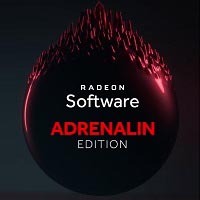Continua senza sosta il processo di affinamento dei driver per le GPU Radeon da parte di AMD, che nell'ultima release ha puntato ai tre titoli più importanti sulla piazza degli eSport.
Grazie al progetto ReSX (Acronimo di Radeon eSports Experience), gli ultimi driver Radeon Adrenalin Edition 18.3.1 hanno fatto registrare un miglioramento degli FPS medi che va dal 3% al 11%, in titoli quali Overwatch (1440p ULTRA), Dota 2 (4K ULTRA) e PUBG (1080p UTRA), rispetto ai precedenti Radeon Adrenalin Edition 17.12.1 (test condotti con GPU Radeon RX580, CPU Intel Core i7-7700K, 16GB RAM @3000MHz, Windows 10 x64).
I nuovi driver non puntano esclusivamente al framerate medio, bensì offrono nelle medesime condizioni un miglioramento che va dal 2% al 9% del frame-time al 99th percentile (Il valore del tempo di frame del 99% dei campioni inferiori o uguali al valore dato, ergo - prendendo in analisi il nel campione dei test - si analizza l'1% dei frame che ha impiegato più del valore riportato per essere processato), oltre ad un più rapido tempo di lettura ed elaborazione dell'input utente su Overwatch (1080p HIGH, inferiore del 4%) e Dota 2 (1080p ULTRA, inferiore del 8%).
Non si tratta certo di cifre che fanno gridare al miracolo ma, senz'altro, sottolineano quanto sia importante il ruolo dei driver grafici e quanto possono incidere ("La potenza è nulla senza controllo", cit.).
AMD ha dichiarato che continuerà a lavorare per portare simili miglioramenti tra i più recenti e popolari titoli del momento, il che non ci dispiace affatto.

• Il download dei driver Radeon Adrenalin Edition 18.3.1 per le diverse piattaforme, insieme maggiori informazioni e relative note di rilascio, sono disponibili a questa pagina.
Introducing Project ReSX
In recent months, we kicked off a special project inside of the Radeon Software group known as Project ReSX (Radeon eSports Experience). The goal of this project was to optimize the performance of some of the most popular PC games in the world on Radeon GPUs, to ensure the best possible eSports experience for Radeon owners.
We approached this problem from multiple angles. We worked with game developers to suggest internal optimizations for their games, including sending engineers to work on site with the game development houses. Meanwhile, we built optimizations into our drivers to improve performance, as well.
Radeon Software 18.3.1 incorporates a host of changes made possible by Project ReSX. All told, it delivers some notable performance improvements over Radeon Software Adrenalin Edition, released late last year. Although we encourage you to test for yourself, here’s a quick look at the improvementsin our upcoming software release made possible by Project ReSX.
Project ReSX isn’t just about higher benchmark scores, though. Our aim is to improve the experience for Radeon GPU owners by ensuring smooth, consistent gameplay. To see how we’re doing there, we looked at the 99th -percentile frame time—sometimes known as the 1% low FPS—to get a sense of how we handle the most difficult frames to render quickly. Here are the results.
As you can see, Radeon GPUs now handle difficult frames more quickly, offering fluid gameplay in PLAYERUNKNOWN BATTLEGROUNDS, Dota 2, and Overwatch. Smooth animation is just one component of the gaming experience, though. Another key part of the picture is responsiveness—specifically, the time between a mouse or key click and the on-screen response, which can be the difference between defeat and victory in a fast-twitch game.
We’ve optimized recent Radeon Software releases to minimize input lag, and the results are clear. The positive results shown above are the product of many hours of hard work from our software and ISV engineering teams in cooperation with some of the world’s top game developers. We’re happy to see that work paying off in Radeon Software 18.3.1, and we will continue to push for similar improvements across the newest and most popular PC games.
Spunti di lettura:

